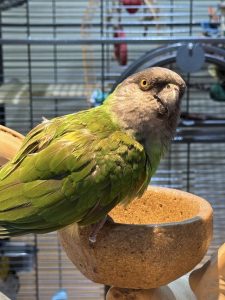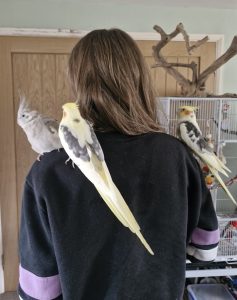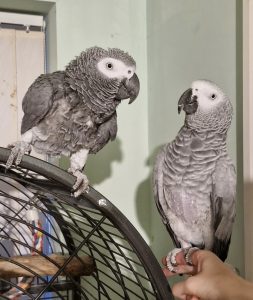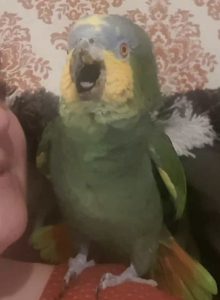
Alexadrine
The Alexandrine Parakeet belongs in the Psittacula, that are known as Parakeets This genus has the distinguishing characteristic of a coloured collar going around the head in the males, or a pronounced stripe running through the chin area. The Alexandrine Parakeets have a large head and bill, a sleek body and a long tapered tail.
The male has a general green plumage with some greyish-blue on the cheeks and a dark purple-red patch on the wing. There is a faint black stripe from the cere to the eye, a black stripe across the lower cheek, and a wide rose-pink collar. The inner tail feathers are bluish-green with light yellow-white tips and a yellow underside. The beak is a deep red with a paler tip. Their average lifespan is 40 years.
The female is lighter than the male. Females don’t have the rose-pink collar or the black stripe across the cheek patches, and they have shorter central tail feathers. These birds grow to a length of 23″ (58 cm).
Further information
The Alex is a lovely, charming little parrot is sometimes called a parakeet; the Alexandrine Parrot is a member of the ring neck type of parrot. You will recognise this parrot because of its colouring mostly it will come as green with some touches of colour but like all parrots there are variations as some have been bred in yellow or blue but they all have the distinctive large beak. And they are all known for their gentle nature.
The Alexandrine Parrot is considered being the best for a great family pet, as they are playful, not nippy and a good talker. Although affectionate, it does not like to be cuddled as much as some other parrots.
They can be noisy – albeit not as noisy as their larger cousins. Not everybody can tolerate the natural call of a ring neck parrot, and even though it can’t be entirely eliminated, there are ways to discourage screaming / screeching in your pet.
The Alexandrine Parakeet is known for its talking ability, and teaching and encouraging your pet alexandrine to talk is one way to reduce undesirable screeching in your pet. So we are giving it 5 out of 10 on our scale.
In the wild, these birds live in small flocks during the day, and roost in very large flocks at night.
The Alexandrine Parrot is a very curious bird. A supply of bird puzzles will help prevent destructive exploration of your home. Give the parrot some wooden toys to destroy. They have the beaks for it and enjoy reducing toys to rubble. Make sure you have a veterinarian that is well-versed in the care of birds and especially parrots and then educate yourself in their care. The Alexandrine Parrot is not a fussy eater. You can change its diet slowly mix the new with the old and in time decrease the old food until he is eating only the new food but don’t forget your parrot needs a variety of other foods as well. The Alexandrine Parrot can learn to like a variety of foods if it’s fed on them from its youth.
Add a few bowls to the regular two that come with its cage to accommodate a choice of foods. Add seed, pellets and fresh fruits and vegetables. Any food that is good for parrots in general will be good for the Alexandrine Parrot. Make sure it has fresh water at all times.
The Alexandrine Parrot needs a good-sized cage. It should measure at least three feet long, two feet wide and two feet high. Most Alexandrines develop long tails, requiring a tall cage. The Alexandrine Parrot is likely to try to stick his head between the bars of the cage so make sure that the bars are too close together to allow it.
Breeding season is from November to April in their natural distribution range.
Average clutch size is 2–4 eggs measuring 34.0 x 26.9 mm (1 x 1.3 in). The average incubation period is 28 days usually starting with the laying of the second egg. The chicks fledge around seven weeks of age. They are reared for about three weeks and are typically weaned between 12 to 16 weeks of age.
Alexandrines are prone to hepatic lipidosis (fatty liver disease) and lipomas (fatty tumors).
They also are prone to bumble foot if they are short on vitamin A and have bad perches.
Psittacula parakeets can also develop atherosclerosis if they’re allowed to become overweight.
There are five sub-species, differing in mostly minor plumage details and size:
P.e. eupatria (nominate Alexandrine Parakeet),
P.e. avensis (Burmese Alexandrine Parakeet),
P.e. magnirostris (Andaman Island’s Alexandrine Parakeet) and
P.e. siamensis (Laos or Siamese Alexandrine Parakeet).
As with all parrots you need to offer a good low sunflower seed diet and fresh fruit and veg daily. Offering lots of different human food in small quantities is a good treat but watch the fat content and avoid poisonous foods!
Please if you have any-more questions or queries please do not hesitate to contact us.
More information
Read more about other parrot species
30+
years experience between our members
30+
years experience between our members
30+
years experience between our members
Our feathered friends
Looking for new homes
From loving tickles to lifelong friend












